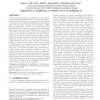Free Online Productivity Tools
i2Speak
i2Symbol
i2OCR
iTex2Img
iWeb2Print
iWeb2Shot
i2Type
iPdf2Split
iPdf2Merge
i2Bopomofo
i2Arabic
i2Style
i2Image
i2PDF
iLatex2Rtf
Sci2ools
KDD
2006
ACM
2006
ACM
Discovering significant OPSM subspace clusters in massive gene expression data
Order-preserving submatrixes (OPSMs) have been accepted as a biologically meaningful subspace cluster model, capturing the general tendency of gene expressions across a subset of conditions. In an OPSM, the expression levels of all genes induce the same linear ordering of the conditions. OPSM mining is reducible to a special case of the sequential pattern mining problem, in which a pattern and its supporting sequences uniquely specify an OPSM cluster. Those small twig clusters, specified by long patterns with naturally low support, incur explosive computational costs and would be completely pruned off by most existing methods for massive datasets containing thousands of conditions and hundreds of thousands of genes, which are common in today's gene expression analysis. However, it is in particular interest of biologists to reveal such small groups of genes that are tightly coregulated under many conditions, and some pathways or processes might require only two genes to act in con...
| Added | 30 Nov 2009 |
| Updated | 30 Nov 2009 |
| Type | Conference |
| Year | 2006 |
| Where | KDD |
| Authors | Byron J. Gao, Obi L. Griffith, Martin Ester, Steven J. M. Jones |
Comments (0)

